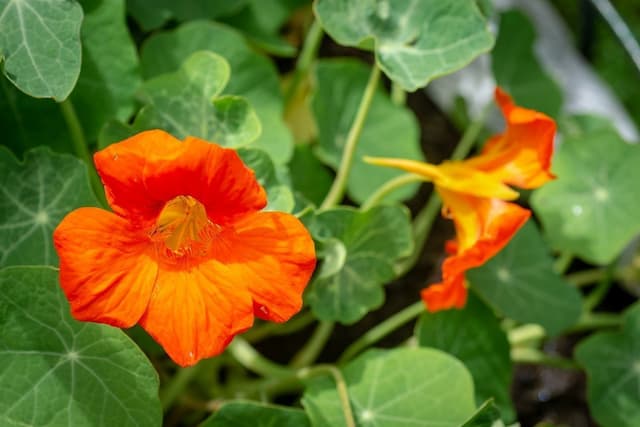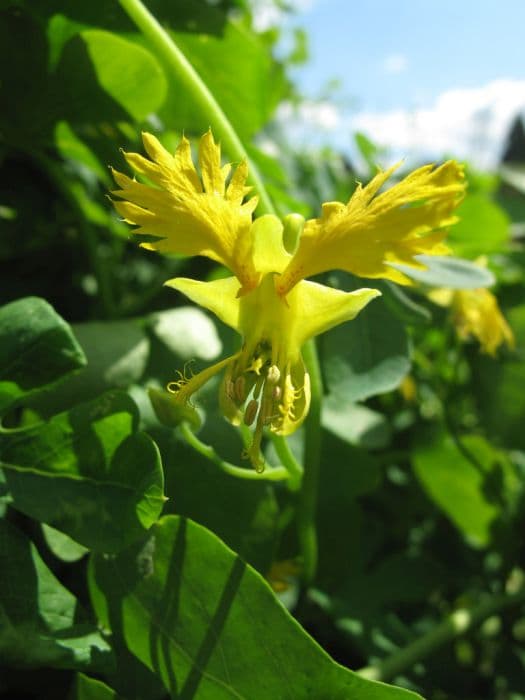Three-coloured Indian Cress Tropaeolum tricolor

ABOUT
The Tropaeolum tricolor, commonly known as Three-Colored Indian Cress or simply Tricolor, is a strikingly beautiful plant notable for its vibrant flowers and graceful foliage. The plant's flowers are an eye-catching assembly of three primary colors: a vivid scarlet to red shade forms the main part of the flower, a rich yellow emerges at the throat, and there are hints of a deep, almost purplish blue at the base of each bloom. This combination gives the plant its name and distinguishes it from other species. Each flower is comprised of five petals with a funnel-like shape, which gives the bloom a tubular appearance from the side view. The spur, a distinct elongation at the back of the flower, is slender and curves gracefully. The long, wiry stems are delicate and appear almost vine-like, with rounded, shield-shaped leaves that are arranged alternately along the stem. The leaves are a bright green color, creating a soft backdrop that further accentuates the vibrancy of the flowers. While the striking flowers are the main attraction, the plant also bears fruit. The fruits are small, dry, and rounded, and they are divided into three sections. It is the combination of the plant's alluring flowers, graceful stems, and lush foliage that makes the Tricolor an admired and sought-after plant for garden enthusiasts and those looking to add a touch of natural color to their surroundings.
About this plant
 Names
NamesFamily
Tropaeolaceae.
Synonyms
Three-Colored Indian Cress, Chilean Nasturtium, Three-Colored Nasturtium, Tripolium.
Common names
Tropaeolum tricolorum, Trophaeum tricolor.
 Toxicity
ToxicityTo humans
The Three-Colored Indian Cress is not commonly listed as a poisonous plant, and there is no significant evidence that it poses a serious risk if ingested by humans. However, as with any plant, individual reactions can vary, and some people might be sensitive to its components. If you suspect poisoning or experience adverse effects after ingesting any part of the Three-Colored Indian Cress, it is recommended to seek medical advice.
To pets
For the Three-Colored Indian Cress, there is not much information available regarding its toxicity to pets. It is not typically known as a toxic plant to dogs or cats. Nevertheless, pets can have different sensitivities, and it is generally recommended to prevent pets from ingesting plants. If your pet shows any signs of illness after consuming any part of the Three-Colored Indian Cress, please contact your veterinarian.
 Characteristics
CharacteristicsLife cycle
Perennials
Foliage type
Deciduous
Color of leaves
Green
Flower color
Mixed
Height
6 feet (1.83 meters)
Spread
3 feet (0.91 meters)
Plant type
Climber
Hardiness zones
9
Native area
Chile
Benefits
 General Benefits
General Benefits- Aesthetic Appeal: Tropaeolum tricolor, commonly known as Three-Colored Indian Cress, adds vibrant color to gardens with its distinctive tri-colored flowers.
- Easy Cultivation: It is considered easy to grow and maintain, which is convenient for gardeners of all levels of experience.
- Pollinator Attraction: The bright blossoms attract pollinators such as bees and butterflies, which are beneficial for garden biodiversity.
- Climbing Habit: This plant can climb structures, which makes it useful for creating vertical accents in landscaping and gardens.
- Edible Parts: Some parts of the plant are edible for humans, adding a peppery flavor to salads and other dishes.
- Seasonal Coverage: Three-Colored Indian Cress has a seasonal life cycle that can help cover bare patches in the garden during certain times of the year.
- Companion Planting: It can serve as a companion plant in the garden, potentially helping to deter certain pests from other plants.
- Soil Erosion Control: When planted in groups, it can help to reduce soil erosion due to its fast-growing nature and ground-covering capability.
 Medical Properties
Medical PropertiesThis plant is not used for medical purposes.
 Air-purifying Qualities
Air-purifying QualitiesThis plant is not specifically known for air purifying qualities.
 Other Uses
Other Uses- Tropaeolum tricolor, commonly known as Tricolor Nasturtium, can be used as a natural food dye due to its vibrant colors, which can add a unique hue to pastries and desserts.
- The petals of Tricolor Nasturtium can be frozen in ice cubes to create decorative elements for summer drinks and cocktails.
- Its leaves can be used in floral crafts, like making living wreaths or as an addition to flower arrangements, due to their ornamental shape and color.
- The seeds of the Tricolor Nasturtium are edible when pickled and can be used as a caper-like condiment in salads and toppings.
- The plant can be used as a trap crop to lure aphids away from other plants in the garden, providing natural pest control.
- Due to its climbing habit, Tricolor Nasturtium can be utilized as a natural privacy screen or living curtain on balconies and patios.
- The bright flowers can be used to make eco-friendly confetti for weddings or celebrations, as they are biodegradable and add a splash of color without harm to the environment.
- As a companion plant, Tricolor Nasturtium can be planted alongside fruit trees to attract pollinators, enhancing pollination and fruit set.
- The dried seed pods of the Tricolor Nasturtium can be used for crafting purposes, such as making jewelry or adding to potpourri mixes.
- Children can be encouraged to engage in gardening by using Tricolor Nasturtium due to its easy-to-grow nature, helping them to learn about plant life cycles and fostering a connection with nature.
Interesting Facts
 Feng Shui
Feng ShuiThe plant Tropaeolum tricolor, commonly known as Three-Colored Indian Cress, is not used in Feng Shui practice.
 Zodiac Sign Compitability
Zodiac Sign CompitabilityThe plant Tropaeolum tricolor, commonly known as Three-Colored Indian Cress, is not used in astrology practice.
 Plant Symbolism
Plant Symbolism- Overcoming Obstacles: The Tropaeolum tricolor, commonly known as "soldier's cap" or "three-colored Indian cress", climbs and sprawls over other vegetation, symbolizing resilience and the ability to overcome challenges.
- Vibrant Energy: With its vividly colored flowers, the plant represents vibrant energy and enthusiasm, evoking a sense of joy and celebration.
- Adaptability: The plant's capacity to thrive in varied conditions reflects adaptability and the ability to flourish despite changing circumstances.
- Courage: Traditionally, plants with bold colors like those of the soldier's cap have been associated with courage and bravery, possibly due to their eye-catching hues that don't shy away from attention.
- Tropaeolum as a Genus: The name "Tropaeolum" comes from the Greek "tropaion" meaning "trophy," which can imbue the plant with connotations of victory and success.
 Water
WaterThe Three-Colored Indian Cress, or Tropaeolum tricolor, prefers consistent moisture during its growing season, which generally means a thorough watering once a week with about one gallon of water. Ensure the soil is well-draining to prevent waterlogged conditions. When the plant is dormant, watering should be reduced significantly, providing only enough to keep the soil from completely drying out. Over-watering can be as detrimental as under-watering, so it's essential to check the top inch of soil for dryness before deciding to add more water.
 Light
LightThe Three-Colored Indian Cress thrives best in bright, indirect light or dappled sunlight. It should not be exposed to direct sunlight during the hottest part of the day as this can scorch the leaves. A spot that receives morning sunlight but is shielded from the intense afternoon sun is ideal for this plant to flourish.
 Temperature
TemperatureThe Three-Colored Indian Cress enjoys mild temperatures, with ideal conditions ranging from 50 to 75°F. It can tolerate temperatures as low as 40°F and as high as 80°F, but the plant will not survive under prolonged exposure to temperatures outside this range. To ensure healthy growth, it should be kept in an environment that doesn't fluctuate wildly in temperature.
 Pruning
PruningPrune the Three-Colored Indian Cress to shape the plant, encourage bushier growth, and remove dead or yellowing leaves. The best time for pruning is in late winter or early spring before new growth begins. Pruning can be done every few months or as needed to maintain the plant's desired size and shape.
 Cleaning
CleaningAs needed
 Soil
SoilThe Three-Colored Indian Cress prefers well-draining soil with a mix of loam, peat, and sharp sand, providing good aeration. The optimal soil pH is slightly acidic to neutral, around 6.0-7.5.
 Repotting
RepottingThe Three-Colored Indian Cress should be repotted every two to three years to refresh the soil and accommodate root growth.
 Humidity & Misting
Humidity & MistingThree-Colored Indian Cress thrives best in moderate humidity levels, ideally around 50% relative humidity.
 Suitable locations
Suitable locationsIndoor
Place in bright, indirect light with some direct sun.
Outdoor
Choose a sunny spot with shelter from strong winds.
Hardiness zone
9-11 USDA
 Life cycle
Life cycleThe Tropaeolum tricolor, also known as Three-Colored Indian Cress or Chilean Nasturtium, begins its life cycle as a dormant tuber which germinates in late fall or early winter. After germination, it sends up climbing or trailing stems with small, lobed leaves. As spring approaches, it produces vivid tricolored flowers, usually red, yellow, and navy blue, which are followed by fruit in the form of a three-sectioned capsule with a single seed in each section. After flowering, the plant goes into a dormant period in summer when the foliage dies back, and it survives the dry season as a tuber. During dormancy, the tuber conserves energy and prepares for the next growing season. With the return of cooler and wetter conditions in autumn, the cycle resumes with the tuber breaking dormancy and the plant starting its growth anew.
 Propogation
PropogationPropogation time
Spring-Early Summer
Tropaeolum tricolor, commonly known as the Three-Colored Indian Cress, is generally propagated through seed sowing. The ideal time to sow seeds for this plant is in the fall. To propagate by seed, first, the hard seed coat should be gently scarified with a file or sandpaper, or soaked in warm water overnight to facilitate water absorption and improve germination rates. After scarification, the seeds can be directly sown into well-draining soil at a depth of approximately half an inch (1.27 centimeters). Ensure the soil stays consistently moist but not waterlogged. With proper care, seedlings will emerge in a few weeks, and the plants can grow to flowering size in a single season. This seed propagation method captures the simplicity and effectiveness of harnessing the natural reproductive cycle of the Three-Colored Indian Cress.




